Many daily items such as hair sprays, nail polish, perfume, and battery-operated toys may seem harmless, but they have a high risk during shipping. And they are dangerous goods. As for dangerous goods shipments, there are many international regulations in all respects you have to obey. Then keep reading to learn more about dangerous goods.
1. Dangerous goods meaning and 9 classes.
What are dangerous goods?
Dangerous goods (DG cargo), also called hazardous material or hazmat, are substances that may pose a risk to people’s health, safety, property, and the environment if mishandled.
They are explosive, flammable, toxic, radioactive, or corrosive, so the ways of sourcing, packaging, shipping, and storing dangerous goods should strictly comply with the dangerous goods regulations and rules to avoid accidents.
Dangerous goods classification
In international transit, there are 9 classes of dangerous goods, which are classified according to the dangerous level and the major danger of hazardous materials. And this part contains a lot of content, you can jump to the following dangerous class you want to know.
Class 1: Explosives

Explosives are materials or items which possess the ability to produce violent chemical reactions. And they can instantly produce a large amount of gas and heat, make the surrounding pressure rise sharply, explode, and cause damage to the surrounding environment at temperatures, pressures, and impacts.
Common examples: Fireworks, Igniters, ammunition/cartridges, fuse, etc.
Class 2: Gases
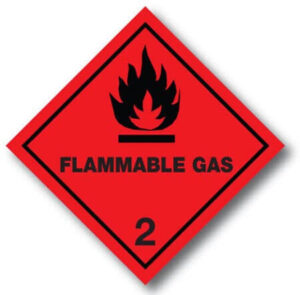
When such gases are heated, impacted, or strongly vibrated, the pressure in the container will increase sharply, causing the container to rupture and explode, or causing the cylinder valve to loosen and leak gas and resulting in fire or poisoning accidents.
Gases include compressed gases, liquefied gases, dissolved gases, refrigerated liquefied gases, mixtures of gases, and aerosol dispensers/articles containing gas.
Common examples: Hair spray, sunscreen spray, fire extinguishers, insecticide gases, etc.
Class 3: Flammable liquids
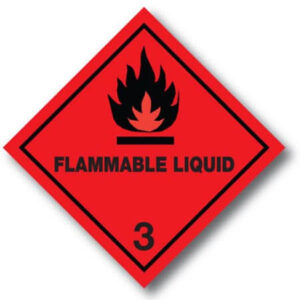
Flammable liquid refers to liquids or liquid mixture that emits flammable vapor at its flash point temperature, or liquid containing solid substances in solution or suspension. And the volatile vapors will cause combustion and explosion, and even enter the human body through the skin, digestive tract, and respiratory tract, resulting in corrosion and poisoning.
Common examples: Paints/varnishes, alcohols, perfume, superglue, gasoline/petrol, etc.
Class 4: Flammable solids
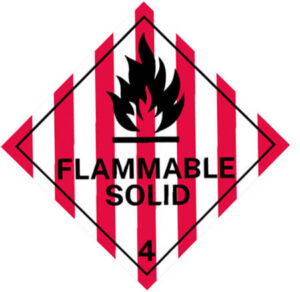
Flammable solids refer to the materials that produce a violent chemical reaction and emit a large amount of flammable gas and heat when encountering water or moisture. Some of them can burn or explode without fire.
Common examples: Safety matches, ping-pong balls, self-heating package, carbon, sulfur, firelighters, etc.
Class 5: Oxidising substances & organic peroxides
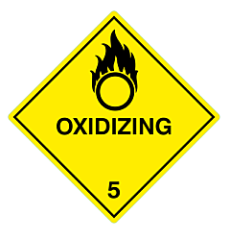
This kind of dangerous goods refers to the substances that are in a high oxidation state with a strong oxidizing property. And they are easy to release oxygen and heat when decompose. They can form an explosive mixture with soft powder combustibles and are sensitive to heat, vibration, or friction, even if they are not always combustible by themselves.
Common examples: Blench, potassium permanganate solution, washing liquid, etc.
Class 6: Toxins and infectious substances
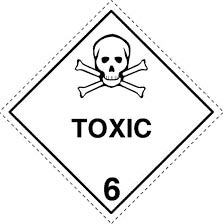
They refer to the substances that can cause biochemical or biophysical changes in body fluids and tissues. And that can disturb or destroy the normal physiological functions of the body, causing temporary or permanent pathological conditions, or even death after entering the body by swallowing, inhalation, or skin contact.
Toxic substances are generally defined as substances that enter the body in small doses and can cause health damage through chemical or physical effects. According to this definition, toxic substances are relative, and the dose determines whether an ingredient is toxic or not. Infectious substances are those which contain microorganisms, such as bacteria, viruses, and parasites which can bring diseases to humans or animals.
Common examples: Ratsbane, arsenic, pesticides, COVID-19 vaccines, living organs, etc.
Class 7: Radioactive material
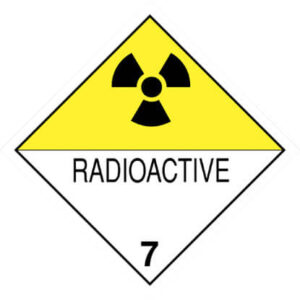
Radioactive materials refer to materials that contain radionuclides with specific activity of more than 74x104bq/kg. And they naturally radiate energy and emit rays that can not be seen or felt by our naked eyes. However, exposure people to radioactive material can lead to radiation sickness and even death.
Radioactive materials and radiotherapy equipment are often used in medical or industry areas.
Common examples: Radium, uranium, and radioactive developer, etc.
Class 8: Corrosives
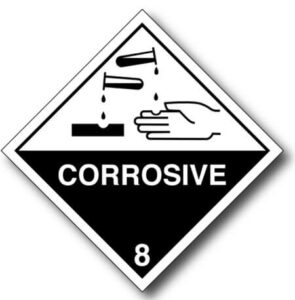
Corrosive products refer to the solid or liquid that can burn human tissues and cause damage to metal and other articles. And the skin shows visible necrosis in contact with the corrosives within 4 hours. And the surface of the 20 # steel with an average annual corrosion rate of more than 6.25mm at a temperature of 55C, once in contact with the corrosives.
Common examples: 84 disinfector, paints, medical thermometer, battery, etc.
Class 9: Miscellaneous dangerous goods

Except for the 8 dangerous goods classes above, other hazardous substances and products belong to Miscellaneous dangerous goods. They may be magnetic, narcotic, toxic, or with other similar properties, which probably endanger flight safety and make flight passengers feel uncomfortable in transit.
Common examples: Phones, lithium batteries, airbags, dry ice, ammonium nitrate fertilizers, etc.
Note: Some dangerous classes have sub-divisions. For example, the class 2 has 2.1: Flammable gases, 2.2: Non-flammable, non-toxic gases, and 2.3: Toxic gases three divisions. Sometimes it’s hard to distinguish which division your dangerous goods belong to. So you can find a professional testing institution to help you.
2. Dangerous goods regulations.
The dangerous goods regulations set rules for the safe and efficient transport of DG cargo based on different modes of transport. They are issued by international associations and local authorities based on UN recommendations.
Sea transport
If you ship DG cargo by sea, your shipments have to obey the International Maritime Dangerous Goods Code(IMDG Code).
IMDG code is an international code for the maritime transport of dangerous goods. It set regulations in packaged form to ensure safe shipping, and prevent marine pollution. And the code is adopted by the International Maritime Organization (IMO) which is the United Nations specialized agency.
And most of the international dangerous goods shipping are marine shipping which is cheap and safe with less regulations and large amount.
Air transport
International Air Transport Association (IATA) is a trade association that focuses on making air traffic businesses profitable, safe, and efficient. It sets standards such as DGR for its member airlines. If you ship DG cargo via IATA’s member airlines, your dangerous goods have to comply with IATA’s Dangerous Goods Regulations (DGR).
International Civil Aviation Organization (ICAO) has set standards for DG cargo shipped by air. For example, if your DG cargo is shipped from China to US by air and meet some shipping regulation disputes with China or US, you can ask ICAO to help you solve this problem.
Express transport
Except for dangerous goods transported by air and sea, some express companies also accept dangerous goods. They have to obey international and national regulations when shipping DG cargo.
Besides, express companies, such as FedEx and UPS, also have their own regulations on dangerous goods shipments. Not all expresses will ship the same categories.
You should learn about not only the international dangerous goods regulations but also the local government ones. For example, if you ship from China, pay attention to the Chinese port you choose. Many Chinese ports accept some DG classes but ban others. For example, you can ship dangerous goods of class 8 and 9 from Tianjin port, but as for classes 2,3,4,5, and 6, you have to ship from other ports like Shanghai port.
Considering the complexity of the DG cargo shipments, you can consult your freight forwarder or sourcing agent.
3. What are UN number, proper shipping name, packaging group?
These three things will be needed when you are packaging, labeling, or preparing customs declaration documents, etc.
UN number
An UN number, also called United Nations number, is a four-digit number ranging from 0004 to 3548. It is assigned by the United Nations Committee of Experts on the Transport of Dangerous Goods. You can find them in the Recommendations on the Transport of Dangerous Goods, also known as the UN Orange Book.
Just like the people’s ID number identifies somebody, the UN number identifies hazardous materials, such as:
- UN1490 – Potassium permanganate
- UN1993 – Flammable liquids
- UN 0009 – Ammunition, incendiary
- UN 3090 – Lithium batteries
Proper shipping name
Proper shipping name is the name to accurately describe the hazard properties and the composition of dangerous goods. And you need it in all shipping documents, notifications, and packaging. Moreover, the proper shipping name is shown in uppercase form.
For example, if your dangerous goods are wastes, the proper shipping name is WASTE.
The UN number and the proper shipping name are usually used together to describe the DG cargo. And the Dangerous Goods Declaration need to include both of them. Here are some examples of them below.
- UN 1987 ALCOHOLS, N.O.S.
- UN 1993 FLAMMABLE LIQUIDS, N.O.S.
- UN 2902, PESTICIDE, LIQUID, TOXIC, N.O.S.
- UN 1263, PAINT, N.O.S.
UN packaging group
Dangerous goods can be packed in 3 UN packaging groups based on the dangerous level.
- Packing Group I: high danger
- Packing Group II: medium danger
- Packing Group III: low danger
The packing group decides the degree of protective packaging you need for your dangerous goods. The packages and containers should pass some tests, so it’s important to pack your goods properly.
Note: Dangerous goods of class 2, division 6.2 and class 7 are not assigned into 3 packing groups based on the dangerous level of DG goods.
4. How to package dangerous goods?
A correct packaging is very important to avoid accidents, shipping delays, and custom fines. Unlike the regular goods, the packaging material of the DG cargo should strictly compliance with regulations.
The dangerous goods should be tightly packaged to prevent leakage and damage. And for some dangerous materials easily affected by moisture and heat, the special containers such as temperature-controlled containers are necessary.
We have known above that there are three kinds of UN packaging groups. If you are not sure how to package your DG cargo and what kind of packaging material you should choose, you can check the test report of your dangerous goods to figure out the packing group. And then you can pack your goods according to the packaging group requirement
Take firework packaging for example
This is a kind of product people usually use in celebration activities. And fireworks belongs to dangerous goods class 1.
There should be 2 kinds of packaging: sales packaging including inner packaging and transportation packaging.
The sales packaging materials of the fireworks shall be moisture-proof plastic, paper, etc, and shall be sealed. The manufacturer should package the fireworks neatly and tightly. What’s more, the inner packaging material should not react with pyrotechnic composition.
As for the transportation packaging, generally, they are corrugated boxes and wooden cases that have passed the stacking test and dropping test. And the gross weight of fireworks products should be no more than 30 kg.
5. How to label dangerous goods?
Labeling and marking dangerous goods correctly are legal requirements. The dangerous goods labels, markings, symbols, and placards show the information about the dangerous goods directly which reminds people to handle the goods with care.
And you should stick the correct DG labels to the package. So before labeling, check the UN number, DG class, and so on.
And then I’ll take labeling fireworks for example. Over the past decade, China’s total fireworks exports have accounted for 85% of the international market. As most of the fireworks are shipped by sea from China. So here are the marine requirements for fireworks labeling.
Take firework labeling for example
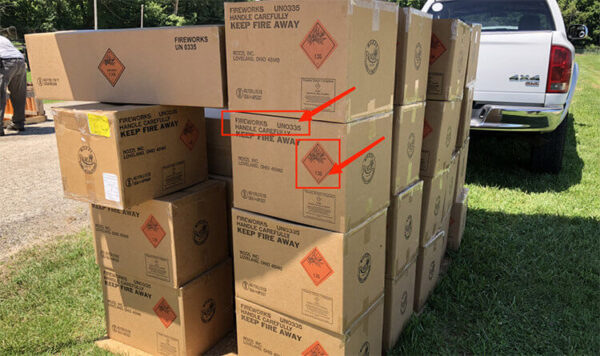
As the kind of fireworks are dangerous goods division 1.3, you should stick the label on the box. What’s more, you should place the UN number and proper shipping name-UN 0335 FIREWORKS on the box too. And here are the details for labeling fireworks regulated by IMDG.
- Label material:Hazard warning labels are made of adhesive material and can keep clear and identifiable after being immersed in seawater for three months.
- Label size: No less than 100mm*100mm, There shall be a dashed outer edge line. And the distance between the outer edge dashed line and the inner edge solid line shall not be less than 5mm. The height of UN number is not less than 12mm. And for goods of 30L or less than 30kgs , shall not be less than 6mm.
- Label position: They shall be posted in a prominent position of the package such as boxes. And they have to be clearly visible, and form a sharp color contrast with the background of the outer package.
- Label quantities: each package of goods shall be labeled with danger signs.
Are You Ready to Arrange Shipments Now?
Let Jingsourcing help you source, package, label, and ship dangerous goods.
6. What dangerous goods documents are needed?
Dangerous goods transport documents usually include DGR (Dangerous Goods Request), MSDS (Material Safety Data Sheet), and DGD (Dangerous Goods Declaration). And they are closely related to each other.
DGR: Given by the seller to the forwarder before packaging the goods. It is called the Dangerous Goods Application. Normally submitted along with the Material Safety Data Sheet (MSDS).
MSDS: It contains information on the goods, and what to do in face of accidents during shipping.
DGD: After the forwarder accepts the DGR, the seller package the dangerous goods and prepare for the DGD. And then the seller give the signed DGD to the forwarder who will arrange and pack the DG cargo into a vessel.
NOTE: You can find a sourcing company to help you arrange all the things, if you have no experience to handle all these things.
Conclusion
As you have learned above, shipping DG cargo can be a big headache as you have to prepare lots of documents, and understand many regulations internationally and domestically.
We are a leading sourcing company in China, dedicated to helping our clients source good products from China with the most competitive prices and offer reliable shipping services which can relieve your headaches. If you want to wholesale or dropship goods including dangerous goods from China, please feel free to CONTACT US.

